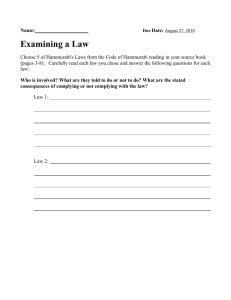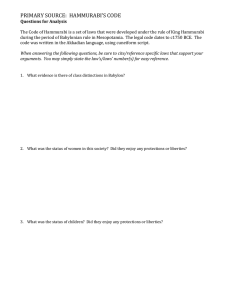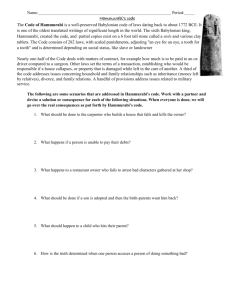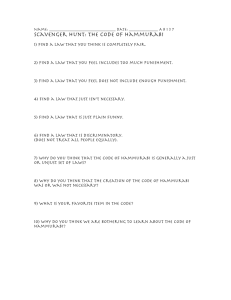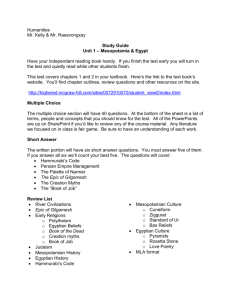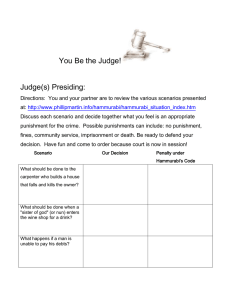Ancient Near East & Egypt Unit Exam
advertisement
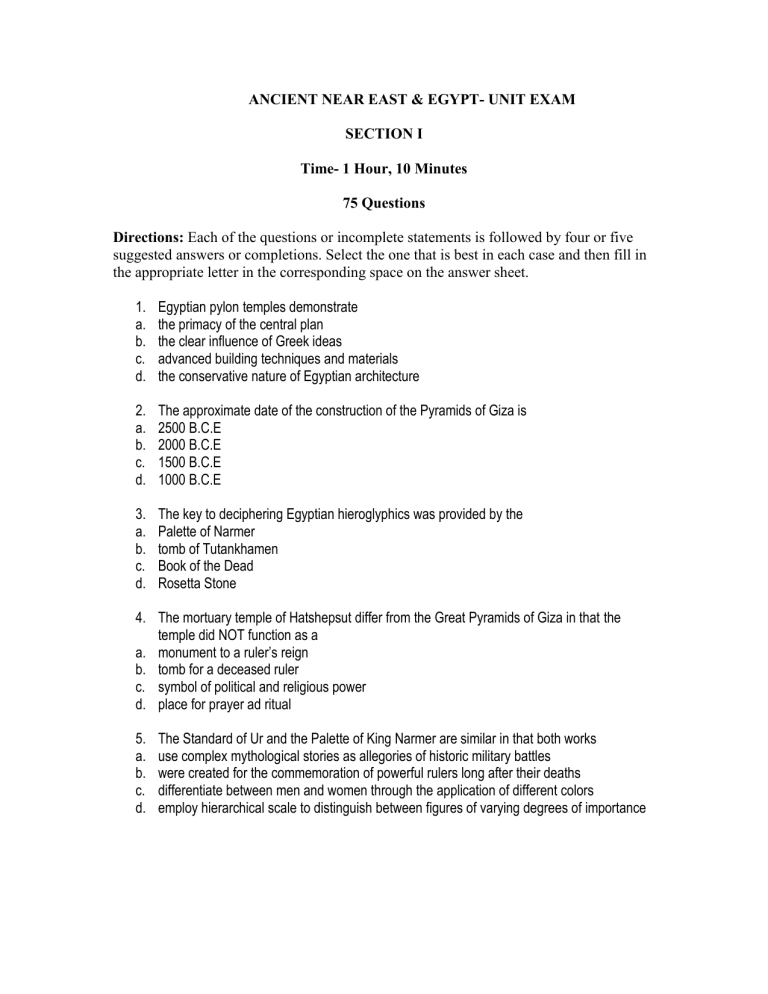
ANCIENT NEAR EAST & EGYPT- UNIT EXAM SECTION I Time- 1 Hour, 10 Minutes 75 Questions Directions: Each of the questions or incomplete statements is followed by four or five suggested answers or completions. Select the one that is best in each case and then fill in the appropriate letter in the corresponding space on the answer sheet. 1. a. b. c. d. Egyptian pylon temples demonstrate the primacy of the central plan the clear influence of Greek ideas advanced building techniques and materials the conservative nature of Egyptian architecture 2. a. b. c. d. The approximate date of the construction of the Pyramids of Giza is 2500 B.C.E 2000 B.C.E 1500 B.C.E 1000 B.C.E 3. a. b. c. d. The key to deciphering Egyptian hieroglyphics was provided by the Palette of Narmer tomb of Tutankhamen Book of the Dead Rosetta Stone 4. The mortuary temple of Hatshepsut differ from the Great Pyramids of Giza in that the temple did NOT function as a a. monument to a ruler’s reign b. tomb for a deceased ruler c. symbol of political and religious power d. place for prayer ad ritual 5. a. b. c. d. The Standard of Ur and the Palette of King Narmer are similar in that both works use complex mythological stories as allegories of historic military battles were created for the commemoration of powerful rulers long after their deaths differentiate between men and women through the application of different colors employ hierarchical scale to distinguish between figures of varying degrees of importance 6. Which of the following is true of both the Standard of Ur from the Royal Tombs at Ur and the Palette of Narmer? a. they portray dynastic succession b. they celebrate military victory c. they designate the king as a sun god d. they depict an enemy’s military banner 7. The Palette of Narmer, created in Egypt around 3,100 BCE, is significant for which of the following reasons? a. it records the building of the largest pyramid in Egypt b. Narmer was a king mentioned in the Old Testament c. It is one of the first identifiable recordings of an historical event in art d. Narmer was the grandfather of Tutankhamen 8. a. b. c. d. A characteristic feature of Egyptian pylon temples was their use of an exterior colonnade corbelled arches sloping façade walls beehive tombs 9. The hunting scenes in Assyrian art that portray wounded or dying lions were meant primarily to a. represent the king’s ritual hunt b. glorify the animals and the king’s power c. study the animal anatomy d. demonstrate hunting techniques 10. a. b. c. d. A bas-relief is formed when the relief sculpture is carved from the back side of the work and hammered out the relief is shallow and slightly raised above the picture plane a sculptor sinks the relief into the surface of the sculpture behind the picture plane a sculptor uses metal tools 11. a. b. c. d. Reliefs leading to the apadana of Darius the Great depict a royal procession subjects of different cultural groups and ethnicities lion hunts the triumphs of Darius in battle 12. Funerary decoration in Old Kingdom Egypt different from those of the New in all of the following EXCEPT a. the use of hierarchical scale b. interaction between figures c. the materials used to create the images d. the use of different ways of depicting the human body 13. The laws expressed on the Code of Hammurabi can be summarized as a. forgiveness is the highest form of justice b. the only way to deter crime is to use the death penalty c. justice depends on your ability to pay d. the punishment reflects the crime 14. The purpose of the sculpture The Seated Scribe is to a. illustrate the large retinue the pharaoh had b. show how the pharaoh was literate and intelligent c. indicate how the pharaoh used scribes to write down his deeds d. attend to the pharaoh’s need in the afterlife Questions 15-17 are based on the image above. 15. a. b. c. d. The art produced during this period involved the construction of monuments to numerous deities the re-establishment of past traditions major architectural innovations radical stylistic change 16. a. b. c. d. The relief shown is most closely associated with the images of Akhenaten Hammurabi Pericles Julius Caesar 17.The work differs from Ti Hunting Hammurabi a. in the use of twisted or composite perspective b. in the integration of text and image c. in the lack of formality between the figures d. in the overwhelming lack of violence Questions 17-20 are based on the image above. 17. a. b. c. d. The work shown above was intended to function as a commemoration of a military victory burial plaque votive offering record of a code of law 18. The laws of the Code of Hammurabi reveal which of the following about Babylonian Society? a. the laws established a minimum wage for Babylonian workers b. the society believed that all people were equal c. the Babylonian society believed that all people were not equal d. Babylonians were skilled at communicating their expectations and consequences for rule violators 19. The stele represents a. Hammurabi presenting temple plans to Shamash b. Hammurabi receiving the rod and ring (rule) from Shamash c. The sun god bestowing mystical powers to Hammurabi d. Hammurabi being scolded by Shamash 19. Which of the following best describes the content of the attached artwork? a. The artwork contains the elements of art form and line and the principle of design proportion b. The artwork is the Code of Hammurabi c. The artwork depicts the god Shamash presenting Hammurabi with items to legitimize his rule d. The Code of Hammurabi was used to communicate the rules of Babylon 20. The Stele of Hammurabi is MOST significant as both a work of ancient Mesopotamian art and as a. A religious artifact recording Babylonian gods b. A key to deciphering cuneiform c. An example of Babylonian literature d. A historical document recording a law code Questions 21-22 are based on the image above. 21. a. b. c. d. The painted, low-relief sculpture is representative of the culture of Old Kingdom Egypt The Aegean Bronze Age Ancient Mesopotamia Early Mesoamerica 22. a. b. c. d. The relief served all of the following purposes EXCEPT to Suggest status and power Decorate a tomb Provide for the ka Document a specific event Questions 23-29 are based on the image above. 23. a. b. c. d. These statues can be attributed to which of the following cultures? Old Kingdom Egypt Assyria Persia Sumeria 24. a. b. c. d. The large eyes of the figures represent Votive offerings Stylistic change Constant wakefulness Masculinity 25. a. b. c. d. The bases of these sculptures often included Portraits of the purchaser Details about specific prayers Demands to the god Prayers of thanks 26. a. b. c. d. These works were found Under a temple In a Turkish tell In a tomb In a mastaba 27. a. b. c. d. Statues like these were created to be representations of the city-state’s patron deity placed in a personal shrine at a patron’s home portraits of the deceased stand-in representations of workers 28. a. b. c. d. 29. The importance of being perpetually attentive is demonstrated by the figure’s rigid stance wide eyes modest garments tiny hands clasped in front of the chest
